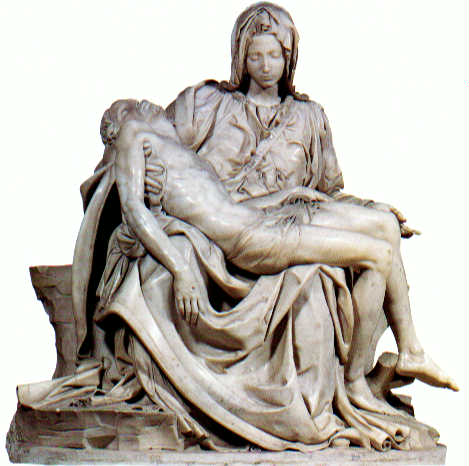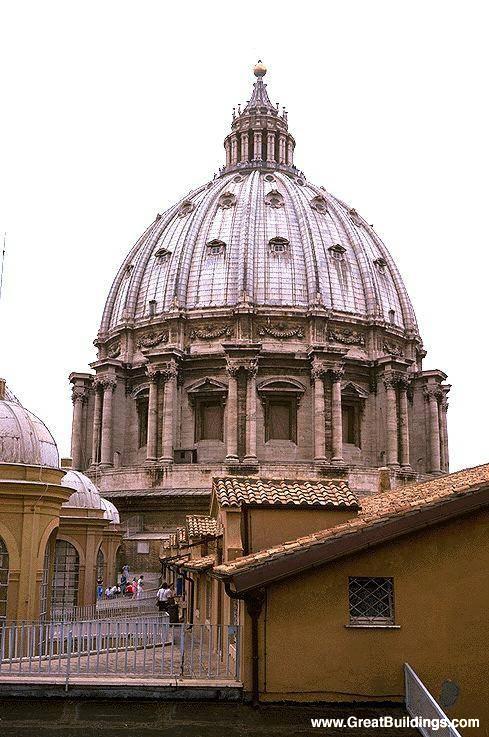|
|
 |
|
Michelangelo's Contributions to Saint Peter's |
|
written
by helenhwu / 10.09.2004 |
|
|
| |
Description |
| |
| |

|
|
| Pieta |
| The Pieta now displayed behind a glass case in St. Peter's |
| |
|
| |

|
|
| St. Peter's |
| Exterior of the church
|
| |
|
| |

|
|
| St. Peter's |
| Interior |
| |
|
The word 'Pieta' means 'mercy' in Italian, and it is an artwork depicting Virgin Mary holding the dead body of Jesus Christ after his cruxification. The subject of this particular artwork is originated from the north of Alps, and has been created in many different forms and shapes by different artists and painters. Traditionally, the pieta portrays the pain connected with the idea of redemption. However, Michelangelo merely a twenty-three year old presented a stand out masterpiece of Madonna and Christ that was never attempted before. Instead of making Madonna an old sorrowful lady caressing over her dead son, a young, a rather celestial Virgin Mary radiating an acceptance of pain. Her head leans slightly forward over the lifeless body of Jesus, and her eyes looking down with slight suffering. If one looks closely, the most intense expression of her sorrow was not through her lips but her hands. Notice that she merely uses one hand namely the right hand to hold up Christ's upper body. This implies her strength and muscularity of her body which is hidden under a beautifully carved long drapery. The figures are out of proportion partly due to the difficulty of the positioning of Christ, an adult man on a woman's lap. In addition, if Jesus were to be in human scale, the Virgin would be sixteen feet tall when standing up. The body of Jesus is that of a perfect male figure, the muscle, the vein, and the nerves all depicted through Michelangelo's meticulous and creative handcraft. Every part of Christ's body is in its exactitude which must not be surprising to us considering his Excellencies in mastering the human anatomy. The marks of cruxification is limited, with a wound on his side, the small nails did not go through his feet. Hence it must be interesting to note the contrast between perfect human bodies like Jesus to an oversized body like Mary. Clearly, Michelangelo did not loose his mind when it comes to choosing the ideal size for Mary in comparison to Jesus. Perhaps it is the subtle enlargement of Mary that makes us feel the power of motherhood hovering over her dead son, thus intensifies the earthly nature of what a perfect mother figure should be. Her youth and beauty signifies the preservation of eternal youth as a virgin. Michelangelo had summarized the innovations of 15 century predecessor like Donatello, and issued a new style for the High Renaissance in the 16 century.
St Peter's dome is designed by Michelangelo. Unlike the Pieta, Michelangelo began the dome project at the age of 72. The most important theme that he tried to come across is the simplicity and divinity of St. Peter in the presence of light. The pointed cupola reveals the mystery of the universe, the miracle of reconciliation between God and man. Shining above, the Eternal city, and the silver grey dome radiates love of God. Most of the work was done on the lower part of the dome. He modified Bramente's Greek cross model of the interior to make it a more unified space. Around the base of the dome, he placed a colonnaded walkway next to the big windows lined up one next to the other. One top of each window, an alternating frame of triangle and semi-elliptical shapes is often used in his design. Just as a foot note, one can also observe such design on the Palazzo Farnese which he helped to design for the Farnese family. On the top of the column that is tied to the dome by beams, but no roofing between the intervals of the column. This is often used in Gothic buildings and he created huge semicircular walls echoing inside the dome to support the weight of the dome. He also replaced the sharp corners of the columns underneath the dome that supposedly support the weight of the dome. The double columns with large pediments break the wall mass over the windows. He made diagonal walls on the four corners of where the columns resided. The dome is on a high drum to give visibility of its massiveness. He had also thickened the exterior walls of the dome. From the outside, he used colossal order, meaning huge flat pilasters around the building's curves and corners to create the rippling, muscular surface. From far away, it creates a step-like movement of the cornice. The oval shaped dome that we see today was not an original intend of Michelangelo's. Regardless, the dome still symbolizes cosmological power for St. Peter who was buried underneath.
|
| |
|
| |
|
|
 |
|



